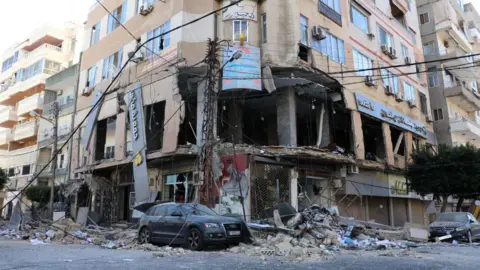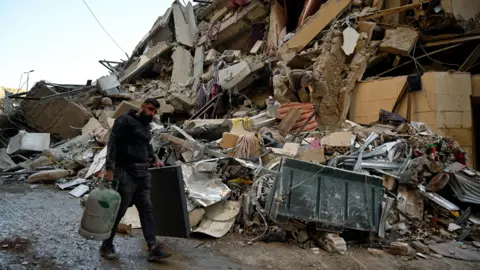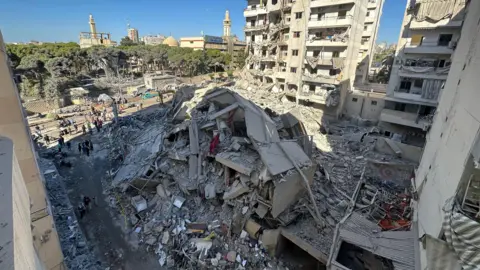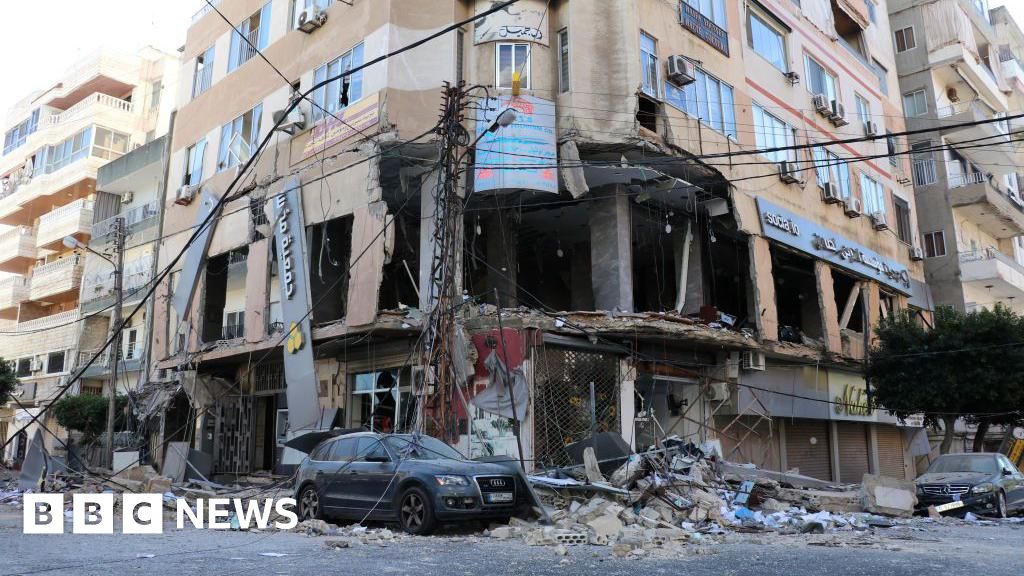What is Israel’s strategy in targeting Hezbollah’s civilian network?
 AFP
AFPWhen Israel declared last month that it would target a Hezbollah-linked Lebanese microloan charity it triggered a frenzied search for a list of the organisation’s branches.
People across the country tried to figure out whether they needed to flee their homes where the branches were located before Israel started bombing.
Al-Qard Al-Hassan Association (AQAH), a charity that offers interest-free microloans, had grown in prominence over the past decade amid US sanctions and the collapse of Lebanon’s banking sector.
Hassan lives with his family in Beirut, 200m (655ft) away from a branch of AQAH.
“We heard about it from this guy Avichay,” he said, referring to Avichay Adraee, a spokesman in Arabic for the Israeli army who announces evacuation orders on social media.
“Then the bombing started in [the southern Beirut suburb of] Dahieh. We could hear it: ‘Boom, boom, boom.’ The kids jump at every ‘boom’.”
With nowhere else to go, Hassan took his family to the seaside, where they spent a sleepless night squeezed together in the car.
The Israeli air force attacked around 30 AQAH branches that night, but the branch next to Hassan’s home was spared, and he went back the next morning.
Israel has been hitting some of the civilian organisations linked to Hezbollah, as part of its campaign in Lebanon.
Aside from the AQAH, it has hit the Islamic Health Society (IHS), funded by Hezbollah, which operates emergency services, hospitals and medical centres across the county. It has also struck its search-and-rescue teams, killing dozens of rescue workers. Israel claims Hezbollah “is using the IHS as a cover for terrorist activities” and that those killed were carrying out military roles – but that is denied by the IHS.
Israel has also hit buildings housing people who had been displaced by its bombing and evacuation orders.
Such attacks raised widespread suspicion here in Lebanon that Israel is targeting the civilian population that is supportive of Hezbollah – widely referred to here as the ‘bi’a’ of Hezbollah, a word that translates literally as “environment”, and is taken to refer to the social base of the group.
It is a community made up of hundreds of thousands of Lebanese who support the party, vote for it, are employed by various civilian organisations linked to it, or are relatives of Hezbollah fighters and members.
Hezbollah’s relationship with that social base – concentrated in Shia-majority areas in the south, the eastern Bekaa valley, and the southern suburbs of Beirut – has long been considered a source of strength for the group.
But it has also placed it in the crosshairs of Hezbollah’s enemies.
Israel says AQAH finances Hezbollah’s military activities – a claim denied by the group, which says it has no role beyond offering small, interest-free loans to ordinary Lebanese, in line with Islamic law’s prohibition on charging interest.
Following the strikes on AQAH branches last month, Israel’s then-defence minister said on X that Israel was “destroying the terrorist organisation’s ability to both launch and buy missiles”.
From an international humanitarian law perspective, experts say AQAH is not a lawful military target regardless of Israel’s claims that it plays a role in financing Hezbollah.
“International humanitarian law does not permit attacks on the economic or financial infrastructure of an adversary, even if they indirectly sustain its military activities,” according to Ben Saul, UN Special Rapporteur on Human Rights and Counter-terrorism.
Mr Saul said the bombing “obliterates the distinction between civilian objects and military objectives” and “opens the door to ‘total war’ against civilian populations”.
 EPA
EPASo what could Israel hope to achieve by bombing civilian organisations linked to Hezbollah?
Amal Saad, a lecturer in politics and international relations at Cardiff University and a leading expert on Hezbollah, believes the attacks are aimed at dismantling what is also known as Hezbollah’s “community of resistance.”
“Hezbollah is probably the second biggest employer after the state,” says Ms Saad. “Its civilian institutions affect hundreds of thousands of Lebanese, mainly Shia. It’s a way of strangulating the community further.”
It would not be the first time Hezbollah’s social base came under attack. During the last war between Israel and Hezbollah in 2006, Israel flattened neighbourhoods in Dahieh, and two years later, revealed a military strategy drawn from that experience – what came to be known as the Dahieh Doctrine.
It was first articulated by then-Maj Gen Gadi Eizenkot in 2008 when he was head of the Israeli military’s Northern Command. This doctrine – as it came to be known – called for applying “disproportionate force” against civilian areas where Israel believes it is attacked from, with the goal of pressuring the people of Lebanon to turn on Hezbollah to undermine support for it.
‘From our perspective, these are military bases…,” he said at the time. “Harming the population is the only means of restraining [Hassan] Nasrallah,” he said, referring to the then-leader of Hezbollah. Nasrallah was killed in an air strike in Dahieh in September 2024.
Now, Israel is striking that population in areas far removed from combat, such as Wardaniyeh, north-east of Sidon, in addition to striking Hezbollah’s network of civilian organisations.
In a response to the BBC, the IDF said it was “operating solely against the Hezbollah terrorist organisation, not against the Lebanese population or medical facilities, and as such takes many measures to mitigate harm to civilians”.
“The IDF operations have been planned based on extensive intelligence gathering and in strict accordance with international law,” it added.
 EPA
EPAAQAH is just one of several organisations linked to Hezbollah that throws lifelines to hundreds of thousands of Lebanese – especially those that form the movement’s base.
Its story is intertwined with that of Lebanon’s financial and economic collapse.
Founded in the early 1980s, it gave out loans to families and newly-weds, helping them meet different personal needs. More recently, the association was also beginning to offer loans for such things as agricultural projects and solar panels.
The US imposed sanctions on AQAH in 2007, saying it was being used by Hezbollah “as a cover to manage its financial activities”.
It was thrust into the spotlight again in August 2019, when the US treasury sanctioned Jammal Trust Bank, claiming, among other things, that it “knowingly facilitates the banking activities of US-designated entities openly affiliated with Hezbollah”, including AQAH. The bank was forced to close less than three weeks later.
But the combination of US sanctions and the collapse of Lebanon’s banking sector in October 2019 caused the association to grow like never before. As a result of sanctions on individuals and entities the US said had links to Hezbollah, Lebanese banks closed accounts of people they suspected might cause them trouble with the US treasury. Many of them took their money to AQAH.
Then, even more people deposited money there due to the collapse of trust in the banking system – after Lebanese banks withheld people’s savings, following the financial and economic collapse in 2019.
AQAH ended up being a support for many Lebanese who were ejected from the financial system due to US sanctions, and then for more people who had nowhere to deposit their savings following the crash.
 Reuters
ReutersMany of them will be among the million or so displaced people scattered across Lebanon today – mostly from the south, the Bekaa, and Beirut’s southern suburbs.
Many of them are crammed together in government-run shelters and empty buildings. They watch helplessly as much of their villages and cities has been decimated by the Israeli military.
Those whose homes are still standing live in fearful anticipation of the next wave of bombing, while those with deposits with AQAH now worry that their savings are gone, in their hour of greatest need.
The displaced have themselves also been bombed, in areas far removed from combat zones – such as in the Christian majority northern village of Aitou, where 23 people were killed in an air strike last month – and their host communities across the country are increasingly uneasy; no-one knows when and where Israel might strike.
Meanwhile in the south, Hezbollah and the Israeli army have been clashing directly for a month now, after Israel launched an invasion of south Lebanon in early October.
Whichever way the fighting on the ground goes, Israel is exerting pressure on Lebanese society as a whole, through its strikes on civilian institutions like AQAH.
Some have argued that such attacks may be part of a strategy aimed at ripping through Lebanon’s social fabric, and transforming the country into a hostile environment for Hezbollah and its “community of resistance”.
#Israels #strategy #targeting #Hezbollahs #civilian #network
Source link

